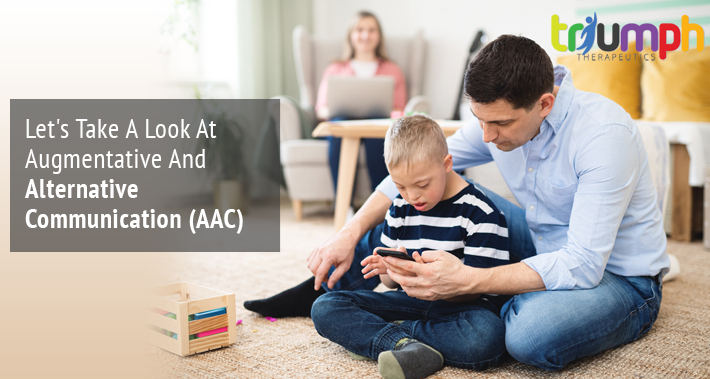Let’s Take A Look At Augmentative And Alternative Communication (AAC)
https://www.triumphtherapeutics.com/wp-content/uploads/2022/02/Triumph-Therapeutics-Speech-Therapy-OT-Physcial-Therapist-Washington-DC-Feb01-01-2022.jpg 710 379 Triumph Therapeutics Triumph Therapeutics https://www.triumphtherapeutics.com/wp-content/uploads/2022/02/Triumph-Therapeutics-Speech-Therapy-OT-Physcial-Therapist-Washington-DC-Feb01-01-2022.jpgIs your child falling behind in their speech and language development?
Has your child recently had a traumatic brain injury that’s made it difficult to communicate?
Do they struggle to communicate as a result of selective mutism, Down syndrome, cerebral palsy, or autism spectrum disorder?
If so, these are two examples of situations where AAC can help.
AAC stands for augmentative and alternative communication, and it’s useful at any age to improve your or your child’s speaking and communication abilities.
There is a wide variety of augmentative and alternative communication tools available.
Speaking to a speech therapist in Washington DC can help you make the best decision about whether AAC is right for your child.
Now, let’s dive in.
What Is Augmentative And Alternative Communication? (AAC)
AAC refers to a variety of different ways that allow you or your child to communicate better.
This means being able to communicate even if you can’t speak at the moment.
Plus, you can use these tools at any age that your communication abilities are impacted.
The length of time you spend using it can be either short term, or long term depending on your needs.
Are There Different Types Of AAC?
There are many different types of augmentative and alternative communication, and you probably use some of them regularly without even thinking about it.
You can group them into three main categories of no tech, low tech, and high tech.
Now, let’s explore the details of each category.
No Tech
Unaided augmentative and alternative communication does not require an external tool.
This means that it relies on your motor control and can include:
- Facial expressions
- Body language
- Finger spelling
- Gestures
- Manual signs
- Vocalizations
- Verbalizations
Low Tech
Low tech options of AAC are non electronic tools that help you to communication.
Some examples of low tech tools include:
- Communication boards
- Pictures
- Photograph
- Writing
- Drawing
- Visual schedules
High Tech
High tech AAC options include tools that are electronic in nature.
Some examples include:
- Computer
- Tablet
- Smart phone
Often, you’ll be using communication apps, text to speech features, texting, or a computer ‘voice’ on these devices to communicate.
If you’ve ever heard Stephen Hawking, the device he used to communicate is one of the highest tech AAC options there are.
See the video below to see what we mean.
You might use one or a blend of multiple types of AAC options.
The goal is to figure out which tools offer you the best results and the most improvement in your communication ability.
Your speech therapist will be a great help to guide you on your journey and will work with you to arrive at the desired solution.
When Does A Child Need AAC?
Your child needs AAC if their current avenues of communication don’t meet their needs.
There are many reasons why this could happen.
They might have a developmental disability which is affecting their speech development.
They might have a disorder that affects their motor skills and their physical ability to speak.
If your child has any type of health challenge that restricts or impairs the quality of their ability to communicate and interact with others, they need it.
And, it’s important that they get the help they need as soon as possible.
There aren’t any milestone requirements your child needs to meet to use one.
This is so that their health challenge doesn’t slow their development and language learning.
The sooner you can get your child to a speech therapist for an evaluation if you suspect they need more tools to communicate, the better.
Your speech therapist will evaluate your child’s needs and determine if they need augmentative and alternative communication based on the following criteria:
- Augmentative communication is needed to facilitate natural speech
- Alternative communication is needed to replace verbal speech, writing, or expressive language
- Communication is required in order to facilitate more appropriate alternate behaviors
Benefits Of AAC
The goal of using AAC is to maximize your efficiency and effectiveness of communication.
This is important because communication is crucial for independence and success in day to day life.
If you’re unable to communicate easily, everything becomes a lot harder.
Some ways that augmentative and alternative communication achieves this is by:
- Improving your functional communication
- Increasing your language and literacy skills
- Improving your speech production and understanding
- Improving your social communication
- Decreasing any challenging behaviors that have resulted from a lack of communication
Book Your Appointment With Triumph Therapeutics Today
There are a lot of benefits to using augmentative and alternative communication tools to improve your speaking and communication.
The sooner you or your child has access to these resources, the better so that you can quickly remove any barriers to communication.
The best person to help you do this is your speech therapist.
They can help you decide what type of tool is the best match for you after their comprehensive evaluation.
Book an appointment today with Triumph Therapeutics to schedule an evaluation.


